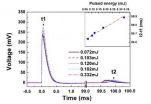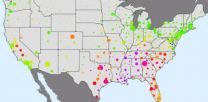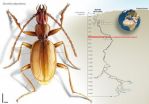(Press-News.org) Experiments aimed at devising new types of photodetectors have been triggered by the increasing use of optoelectronic devices in personal electronics, cameras, medical equipment, computers and by the military. Professor Zhao Kun and co-researchers at the State Key Laboratory of Petroleum Resource and Prospecting, part of the China University of Petroleum in Beijing, have proposed a new type of infrared photodetector.
Photodetectors, which can convert photons to electrical signals, are used to observe and measure the wavelength or energy of light, including infrared light, which is beyond the visible spectrum. Many different types of photodetectors have been widely used in optoelectronic devices, such as digital cameras or night vision goggles. Scientists around the world are constantly exploring the potential to devise, or are actually developing, new generations of photodetectors that feature new configurations or new materials.
Zhao and colleagues state in a new study, "Double peaked decay of transient photovoltage in a nanoporous ZnO/n-Si photodetector," that this ZnO/n-Si structure has an application as a new, simple and low-cost photo-energy detector for an infrared pulsed laser. The paper was published in SCIENCE CHINA Physics, Mechanics & Astronomy.
Zinc oxide (ZnO) is a low-cost and environment-friendly semiconductor. It has a wide band gap (~3.37 eV) at room temperature, so that only ultraviolet light (with a wavelength less than 400 nm) can be absorbed effectively. In terms of photodetector applications, ZnO and ZnO-based devices are routinely studied as an ultraviolet light photosensor.
Yet researcher Zhao and his group now report that when ZnO is combined with n-type Si, an interesting photoresponse is observed under near infrared pulsed light irradiation. "In the present work, we propose a type of infrared photodetector based on a nanoporous ZnO/n-Si structure, which is synthesized by a simple sol-gel method," they state in the study. "Under illumination of one infrared laser pulse, this porous structure exhibits a double peak on a millisecond time scale in the decay of transient photovoltage."
As the structure was irradiated by a pulsed laser with a wavelength of 1064 nm, one laser pulse with energy of 0.072 mJ triggered two peaks: a higher photovoltaic (HPV) peak with an amplitude of ~235 mV and a succeeding lower photovoltaic (LPV) peak with an amplitude of ~13 mV. The time interval (t2-t1) was ~99.64 ms; t1 and t2 represent the corresponding time of the related transient photovoltaic peaks (as shown in Figure 1).
When the pulsed energy increased from 0.072 mJ to 0.332 mJ, the amplitude of the corresponding higher photovoltaic peaks increased from ~235 mV to ~275 mV. In contrast, the amplitude of the LPV peaks remained almost the same, that is, ~13 mV. The authors posited that this particular photoresponse of the nanoporous ZnO/n-Si structure originated from the synergy of the photoelectric effect and the photo-thermal excitation process.
Most importantly, the time interval between the double peaks of transient photovoltage is highly sensitive to slight changes in the energy of the laser pulse. When the irradiated pulsed energy is increased, the time interval (t2-t1) increases linearly.
This characteristic indicates that the nanoporous ZnO/n-Si structure has the potential to be developed into a new, inexpensive photodetector for an infrared pulsed laser.
INFORMATION:
This study received funding from the National Key Basic Research Program of China, the Specially Funded Program on National Key Scientific Instruments and Equipment Development, the Beijing National Science Foundation, and the Science Foundation of the China University of Petroleum.
See the article:
Liu H, Fu C, Zhao K., "Double-peaked decay of transient photovoltage in a nanoporous ZnO/n-Si photodetector" Sci China-Phys Mech Astron, 2014, 57 (6): 1201-1205.
doi: 10.1007/s11433-014-5459-4
http://link.springer.com/article/10.1007%2Fs11433-014-5459-4
Science China Press is a leading publisher of scientific journals in China, and operates under the auspices of the Chinese Academy of Sciences. Science China Press presents to the world leading-edge advancements made by Chinese scientists across a spectrum of fields.
http://www.scichina.com/
A new method to detect infrared energy using a nanoporous ZnO/n-Si photodetector
2014-07-01
ELSE PRESS RELEASES FROM THIS DATE:
Drink walkers do it because their mates think it's okay: QUT study
2014-07-01
Friends may be the key to stopping their mates drink walking, a risky behaviour that kills on average two Australians every week, a QUT study has found.
Researcher Dr Ioni Lewis, from QUT's Centre for Accident Research & Road Safety - Queensland (CARRS-Q), said in a survey of young people aged 17 to 25, friends were the strongest influence on their intentions to drink walk.
"Drink walking, or walking while intoxicated in a public place, is linked to increased risk of injury and fatality," Dr Lewis said.
In a survey, published in Transportation Research, more than ...
EORTC presents European solution for effective cancer drug development
2014-07-01
Drug developers are facing the perfect storm. They are confronted with major patent expiries, increased payer scrutiny, changing priorities, shifting business models, increased risk averseness, increased clinical trial costs, not to mention issues concerning R&D productivity. There needs to be a better way to identify new candidate drugs. There needs to be a new drug development pathway that is compatible with research aimed at understanding the biology of a cancer and simultaneously able to support the design and conduct of subsequent confirmatory trials, but building ...
Unsuspected aspect of immune regulation revealed
2014-07-01
A discovery by Australian immunologists, uncovering an additional role for antibody-making 'B cells', is considered important enough by the American Association of Immunologists to rank it among the top 10% of articles in the latest issue of The Journal of Immunology, off the press today.
The finding by Senior Research Assistant Stacey Walters and Associate Professor Shane Grey, from Sydney's Garvan Institute of Medical Research, shows that B cells also participate in the development of 'regulatory T cells'.
T cells develop in the thymus gland, a soft triangular organ ...
New analysis of 'swine flu' pandemic conflicts with accepted views on how diseases spread
2014-07-01
The most detailed analysis to date of the spread of the H1N1 2009 pandemic influenza virus, known informally as 'swine flu', has found that short-range travel was likely the primary driver for the 2009 pandemic in the United States, in contrast with popularly accepted views on the way diseases spread.
The study, based on data gathered from health insurance claims made throughout 2009, found that international air travel, which was previously thought to be important in the pandemic, played only a minor role in its spread within the US.
A team of researchers from University ...
Cancer risk: Aspirin and smoking affect aging of genes
2014-07-01
The risk of developing cancer increases with age. Factors like smoking and regular aspirin use also affect the risk of cancer – although in the opposite sense. Researchers from the University of Basel were now able to show that aspirin use and smoking both influence aging processes of the female genome that are connected to colorectal cancer. The Journal of the National Cancer Institute has published their results.
Already in the 1990s, scientists discovered that regular use of aspirin over long periods of time decreases the cancer risk. Since then, numerous studies have ...
Analysis of the Chinese facial profile: Contours of the side face in the Tu & Zang ethnic minorities
2014-07-01
Li Haijun and fellow researchers at Minzu University of China, in Beijing, conducted a series of geometric morphometric analyses of the contours of the side face and variations in the Tu and Zang (Tibetan) ethnic minorities from Qinghai Province, in northwestern China.
Their study, entitled "Morphometric analysis of the Chinese facial profile: Contours of the side face and variations in the Tu and Zang ethnic minorities", was published (in Chinese) in the Chinese Science Bulletin, 2014, Vol 59(16).
The team of researchers used advanced digital cameras and image processing ...
A Spaniard and a Portuguese discover a new species of beetle in the world's deepest cave
2014-07-01
The unusual habitat of the Krubera cave in the Western Caucasus remains a mystery. Researchers from two Spanish universities have discovered a new species of beetle in the depths of this cave.
Cave beetles are one of the most iconic species found in subterranean habitats. They were historically the first living organisms described by science that are adapted to the conditions of hypogean or subterranean life.
Now, a Portuguese scientist and a Spaniard have discovered a new species of beetle in the deepest cave known to man; a cave 2,140 metres deep. It is the Krubera ...
Scientists uncover the key to adaptation limits of ocean dwellers
2014-07-01
The simpler, the more heat-resistant – scientists uncover the key to adaptation limits of ocean dwellers
Bremerhaven, Germany, 1 July 2014. The simpler a marine organism is structured, the better it is suited for survival during climate change. Scientists of the Alfred Wegener Institute, Helmholtz Centre for Polar and Marine Research discovered this in a new meta-study, which appears today in the research journal Global Change Biology. For the first time biologists studied the relationship between the complexity of life forms and the ultimate limits of their adaptation ...
The biology of addiction risk looks like addiction
2014-07-01
Philadelphia, PA, July 1, 2014 – Research suggests that people at increased risk for developing addiction share many of the same neurobiological signatures of people who have already developed addiction. This similarity is to be expected, as individuals with family members who have struggled with addiction are over-represented in the population of addicted people.
However, a generation of animal research supports the hypothesis that the addiction process changes the brain in ways that converge with the distinctive neurobiology of the heritable risk for addiction. In other ...
In study of individual neuron activity, key brain region responds to subjective perception
2014-07-01
LOS ANGELES (June 30, 2014) – When evaluating another person's emotions – happy, sad, angry, afraid – humans take cues from facial expressions. Neurons in a part of the brain called the amygdala "fire" in response to the visual stimulation as information is processed by the retina, the amygdala and a network of interconnected brain structures. Some of these regions respond just to the actual features of the face, whereas others respond to how things appear to the viewer, but it is unknown where in the brain this difference arises.
Although the amygdala's importance in ...



